University Project: Industrial Techniques in Maintenance Management
VerifiedAdded on 2023/06/05
|9
|1057
|337
Project
AI Summary
This project focuses on applying project management techniques to industrial maintenance management. It includes network and critical path analysis, bar charts for labor allocation, and schedule refinement. The project estimates time and standard deviation, calculates probabilities of project completion, and optimizes costs using crashing methods. It covers topics such as determining the critical path, calculating the probability of completing a project within a specified timeframe, and optimizing project costs through crashing. The analysis includes calculations for estimated completion time with a 97% certainty. The document provides a detailed approach to managing and optimizing maintenance projects. Desklib provides a platform for students to access similar solved assignments and study resources.

Running head: PROJECT MANAGEMENT
MRE5003: Industrial techniques in maintenance management
Student Name:
University Name:
MRE5003: Industrial techniques in maintenance management
Student Name:
University Name:
Paraphrase This Document
Need a fresh take? Get an instant paraphrase of this document with our AI Paraphraser
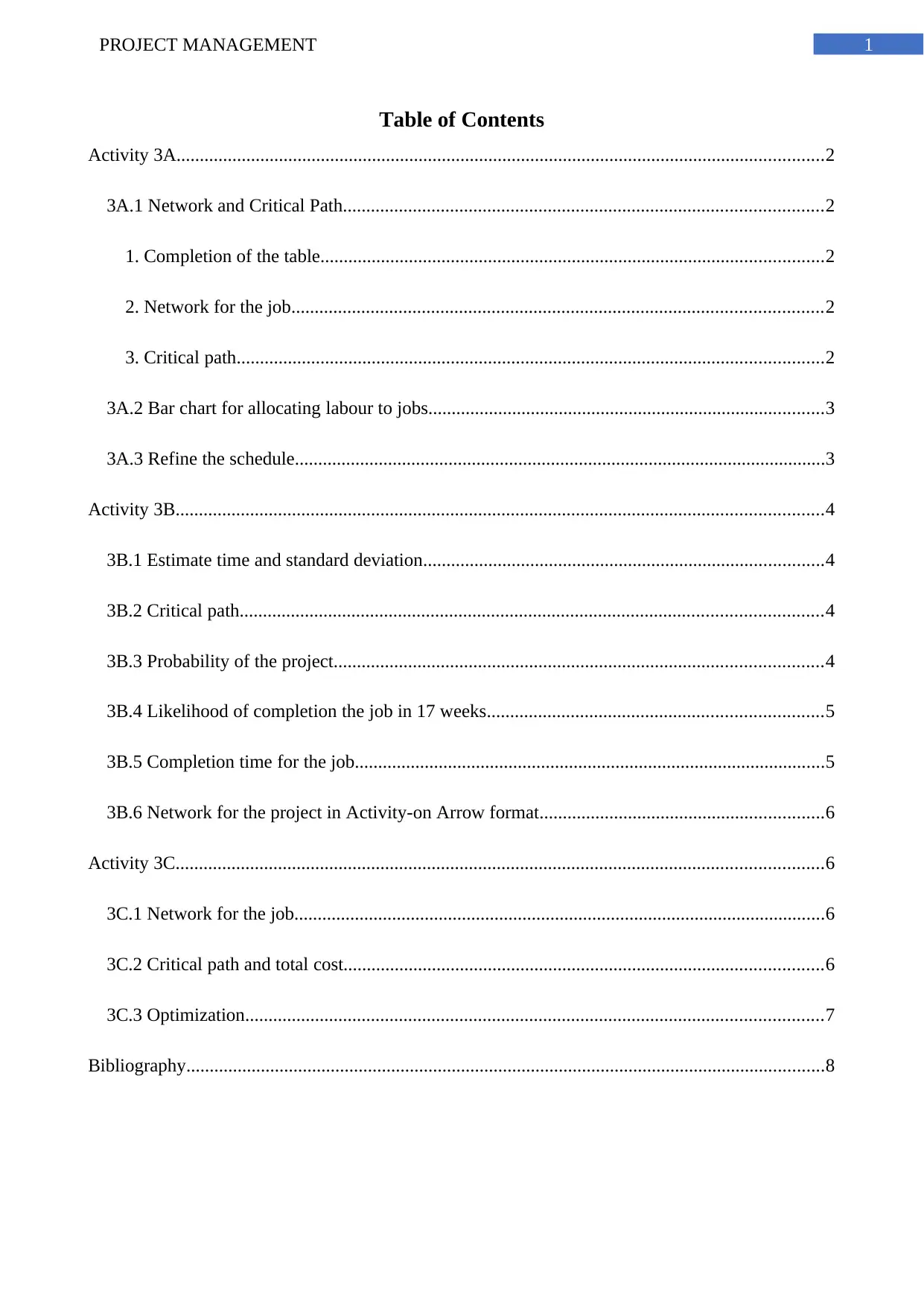
1PROJECT MANAGEMENT
Table of Contents
Activity 3A...........................................................................................................................................2
3A.1 Network and Critical Path.......................................................................................................2
1. Completion of the table............................................................................................................2
2. Network for the job..................................................................................................................2
3. Critical path..............................................................................................................................2
3A.2 Bar chart for allocating labour to jobs.....................................................................................3
3A.3 Refine the schedule..................................................................................................................3
Activity 3B...........................................................................................................................................4
3B.1 Estimate time and standard deviation......................................................................................4
3B.2 Critical path.............................................................................................................................4
3B.3 Probability of the project.........................................................................................................4
3B.4 Likelihood of completion the job in 17 weeks........................................................................5
3B.5 Completion time for the job.....................................................................................................5
3B.6 Network for the project in Activity-on Arrow format.............................................................6
Activity 3C...........................................................................................................................................6
3C.1 Network for the job..................................................................................................................6
3C.2 Critical path and total cost.......................................................................................................6
3C.3 Optimization............................................................................................................................7
Bibliography.........................................................................................................................................8
Table of Contents
Activity 3A...........................................................................................................................................2
3A.1 Network and Critical Path.......................................................................................................2
1. Completion of the table............................................................................................................2
2. Network for the job..................................................................................................................2
3. Critical path..............................................................................................................................2
3A.2 Bar chart for allocating labour to jobs.....................................................................................3
3A.3 Refine the schedule..................................................................................................................3
Activity 3B...........................................................................................................................................4
3B.1 Estimate time and standard deviation......................................................................................4
3B.2 Critical path.............................................................................................................................4
3B.3 Probability of the project.........................................................................................................4
3B.4 Likelihood of completion the job in 17 weeks........................................................................5
3B.5 Completion time for the job.....................................................................................................5
3B.6 Network for the project in Activity-on Arrow format.............................................................6
Activity 3C...........................................................................................................................................6
3C.1 Network for the job..................................................................................................................6
3C.2 Critical path and total cost.......................................................................................................6
3C.3 Optimization............................................................................................................................7
Bibliography.........................................................................................................................................8
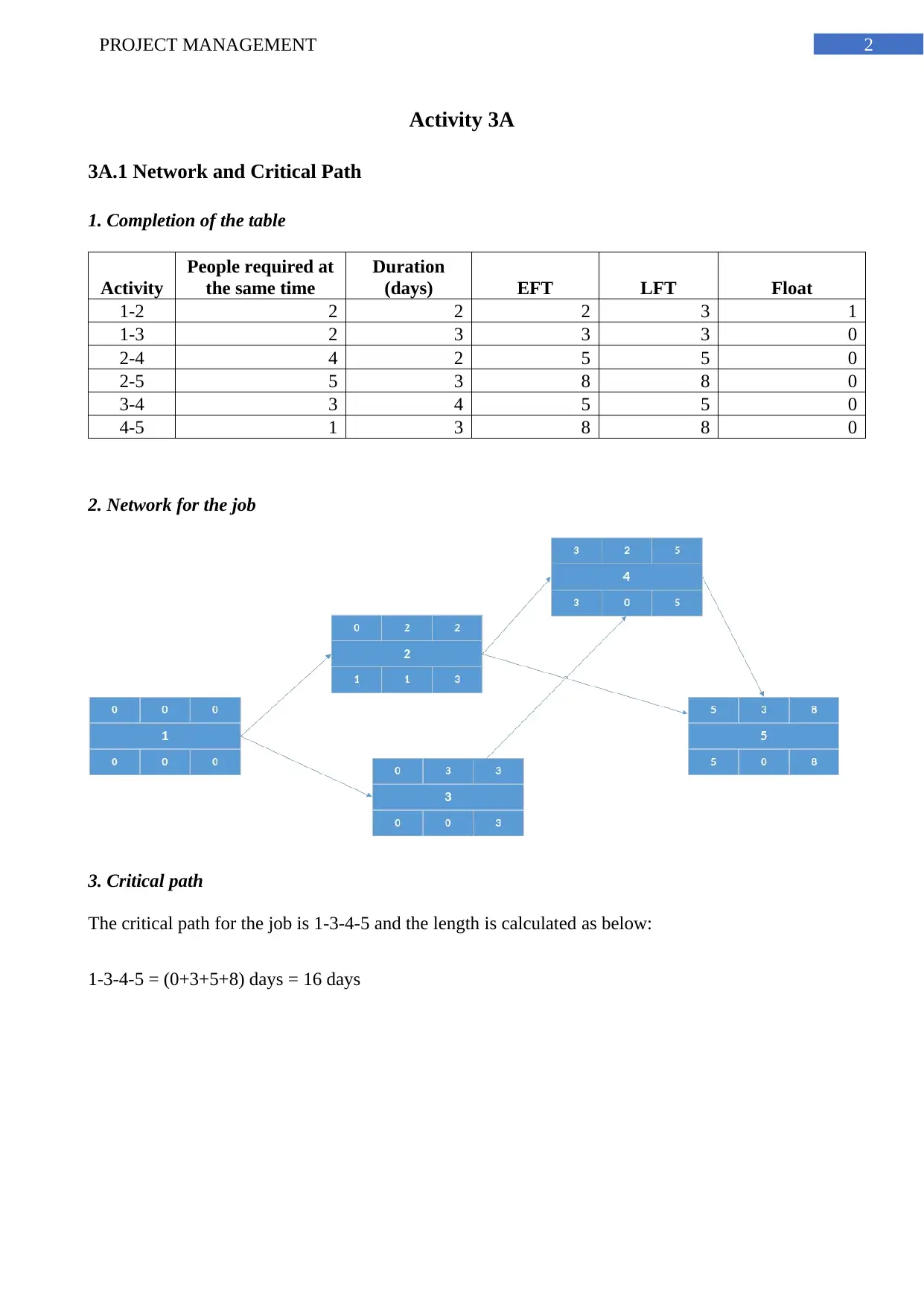
2PROJECT MANAGEMENT
Activity 3A
3A.1 Network and Critical Path
1. Completion of the table
Activity
People required at
the same time
Duration
(days) EFT LFT Float
1-2 2 2 2 3 1
1-3 2 3 3 3 0
2-4 4 2 5 5 0
2-5 5 3 8 8 0
3-4 3 4 5 5 0
4-5 1 3 8 8 0
2. Network for the job
3. Critical path
The critical path for the job is 1-3-4-5 and the length is calculated as below:
1-3-4-5 = (0+3+5+8) days = 16 days
Activity 3A
3A.1 Network and Critical Path
1. Completion of the table
Activity
People required at
the same time
Duration
(days) EFT LFT Float
1-2 2 2 2 3 1
1-3 2 3 3 3 0
2-4 4 2 5 5 0
2-5 5 3 8 8 0
3-4 3 4 5 5 0
4-5 1 3 8 8 0
2. Network for the job
3. Critical path
The critical path for the job is 1-3-4-5 and the length is calculated as below:
1-3-4-5 = (0+3+5+8) days = 16 days
⊘ This is a preview!⊘
Do you want full access?
Subscribe today to unlock all pages.

Trusted by 1+ million students worldwide
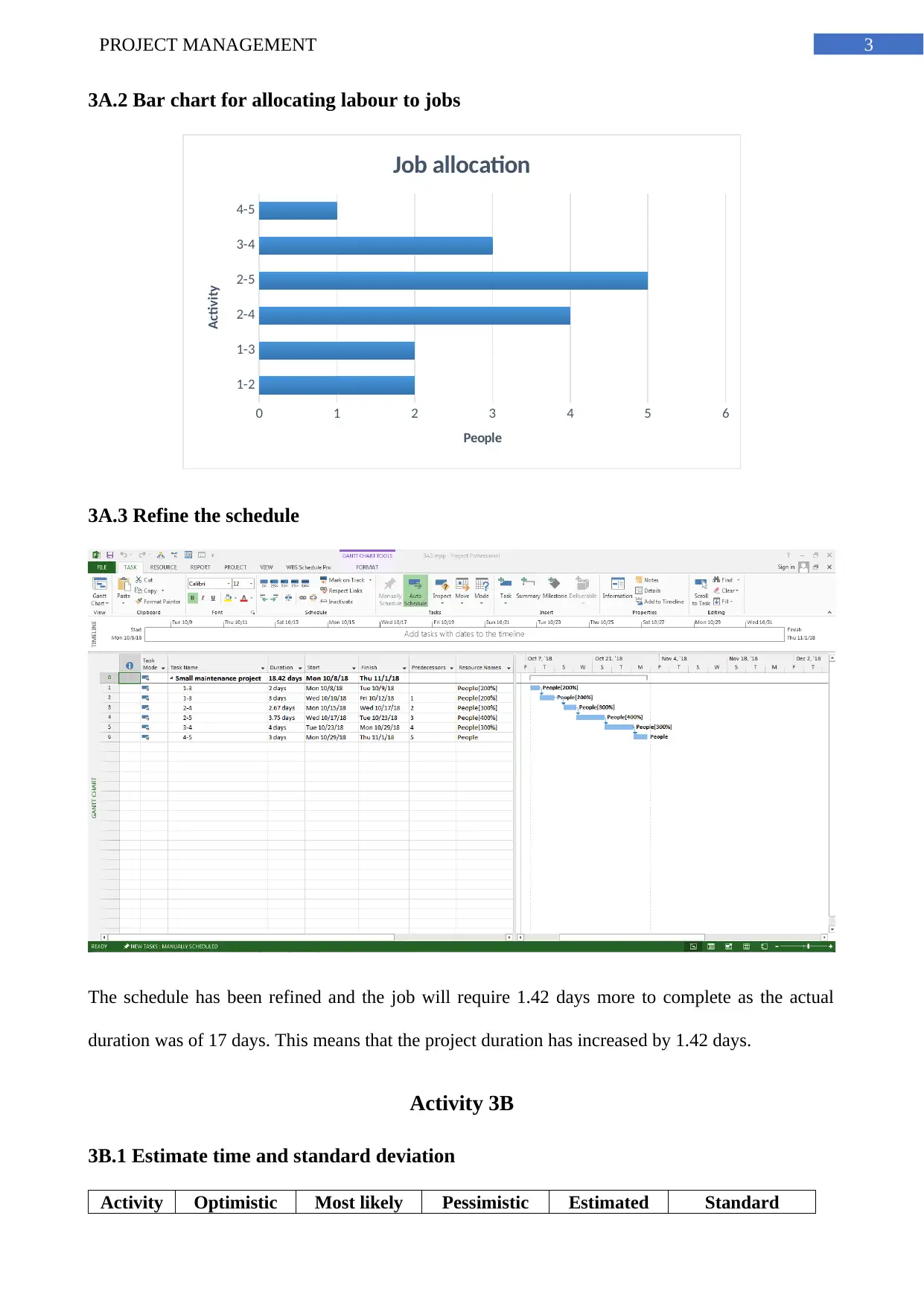
3PROJECT MANAGEMENT
3A.2 Bar chart for allocating labour to jobs
1-2
1-3
2-4
2-5
3-4
4-5
0 1 2 3 4 5 6
Job allocation
People
Activity
3A.3 Refine the schedule
The schedule has been refined and the job will require 1.42 days more to complete as the actual
duration was of 17 days. This means that the project duration has increased by 1.42 days.
Activity 3B
3B.1 Estimate time and standard deviation
Activity Optimistic Most likely Pessimistic Estimated Standard
3A.2 Bar chart for allocating labour to jobs
1-2
1-3
2-4
2-5
3-4
4-5
0 1 2 3 4 5 6
Job allocation
People
Activity
3A.3 Refine the schedule
The schedule has been refined and the job will require 1.42 days more to complete as the actual
duration was of 17 days. This means that the project duration has increased by 1.42 days.
Activity 3B
3B.1 Estimate time and standard deviation
Activity Optimistic Most likely Pessimistic Estimated Standard
Paraphrase This Document
Need a fresh take? Get an instant paraphrase of this document with our AI Paraphraser
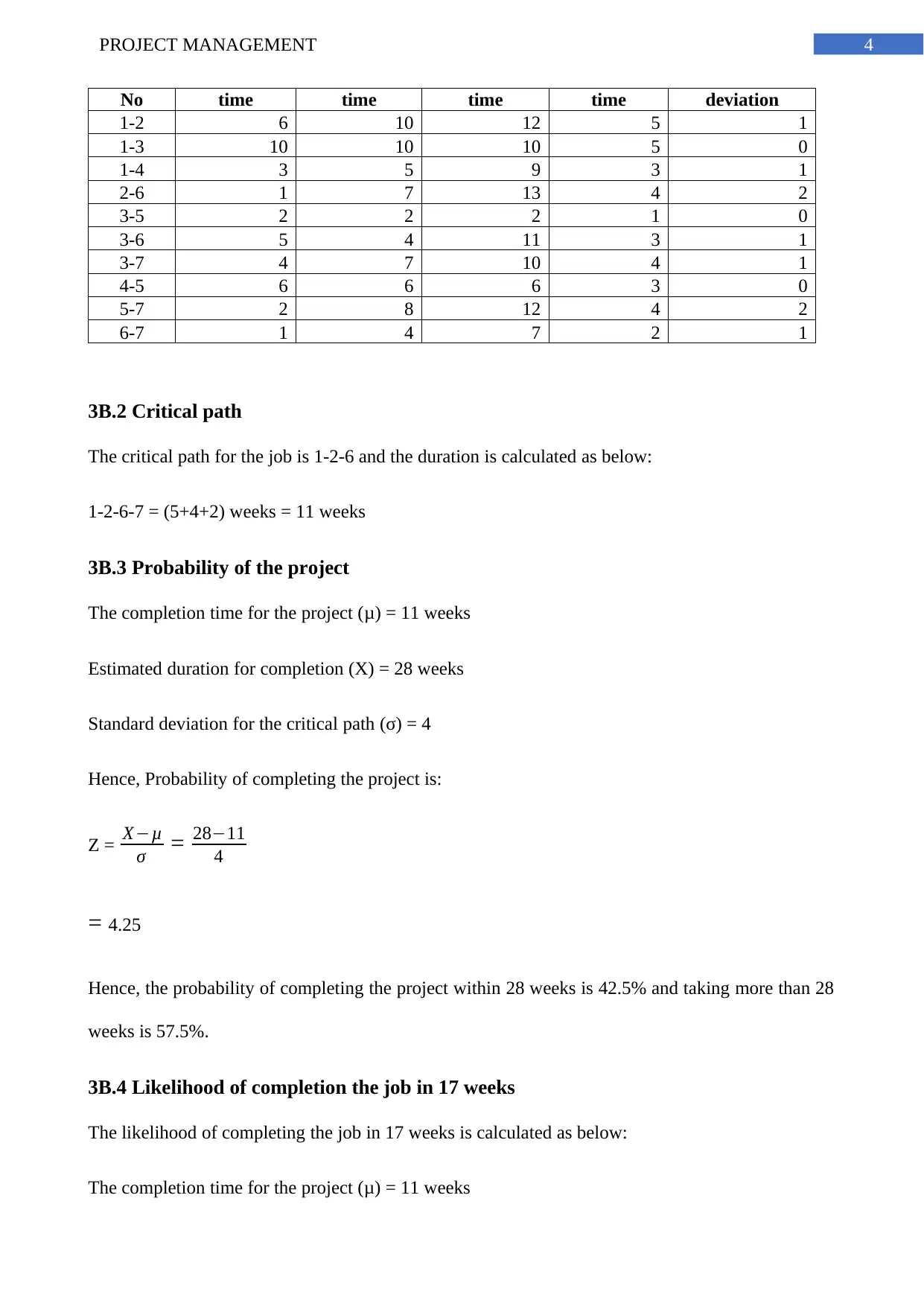
4PROJECT MANAGEMENT
No time time time time deviation
1-2 6 10 12 5 1
1-3 10 10 10 5 0
1-4 3 5 9 3 1
2-6 1 7 13 4 2
3-5 2 2 2 1 0
3-6 5 4 11 3 1
3-7 4 7 10 4 1
4-5 6 6 6 3 0
5-7 2 8 12 4 2
6-7 1 4 7 2 1
3B.2 Critical path
The critical path for the job is 1-2-6 and the duration is calculated as below:
1-2-6-7 = (5+4+2) weeks = 11 weeks
3B.3 Probability of the project
The completion time for the project (μ) = 11 weeks
Estimated duration for completion (X) = 28 weeks
Standard deviation for the critical path (σ) = 4
Hence, Probability of completing the project is:
Z = X−μ
σ = 28−11
4
= 4.25
Hence, the probability of completing the project within 28 weeks is 42.5% and taking more than 28
weeks is 57.5%.
3B.4 Likelihood of completion the job in 17 weeks
The likelihood of completing the job in 17 weeks is calculated as below:
The completion time for the project (μ) = 11 weeks
No time time time time deviation
1-2 6 10 12 5 1
1-3 10 10 10 5 0
1-4 3 5 9 3 1
2-6 1 7 13 4 2
3-5 2 2 2 1 0
3-6 5 4 11 3 1
3-7 4 7 10 4 1
4-5 6 6 6 3 0
5-7 2 8 12 4 2
6-7 1 4 7 2 1
3B.2 Critical path
The critical path for the job is 1-2-6 and the duration is calculated as below:
1-2-6-7 = (5+4+2) weeks = 11 weeks
3B.3 Probability of the project
The completion time for the project (μ) = 11 weeks
Estimated duration for completion (X) = 28 weeks
Standard deviation for the critical path (σ) = 4
Hence, Probability of completing the project is:
Z = X−μ
σ = 28−11
4
= 4.25
Hence, the probability of completing the project within 28 weeks is 42.5% and taking more than 28
weeks is 57.5%.
3B.4 Likelihood of completion the job in 17 weeks
The likelihood of completing the job in 17 weeks is calculated as below:
The completion time for the project (μ) = 11 weeks
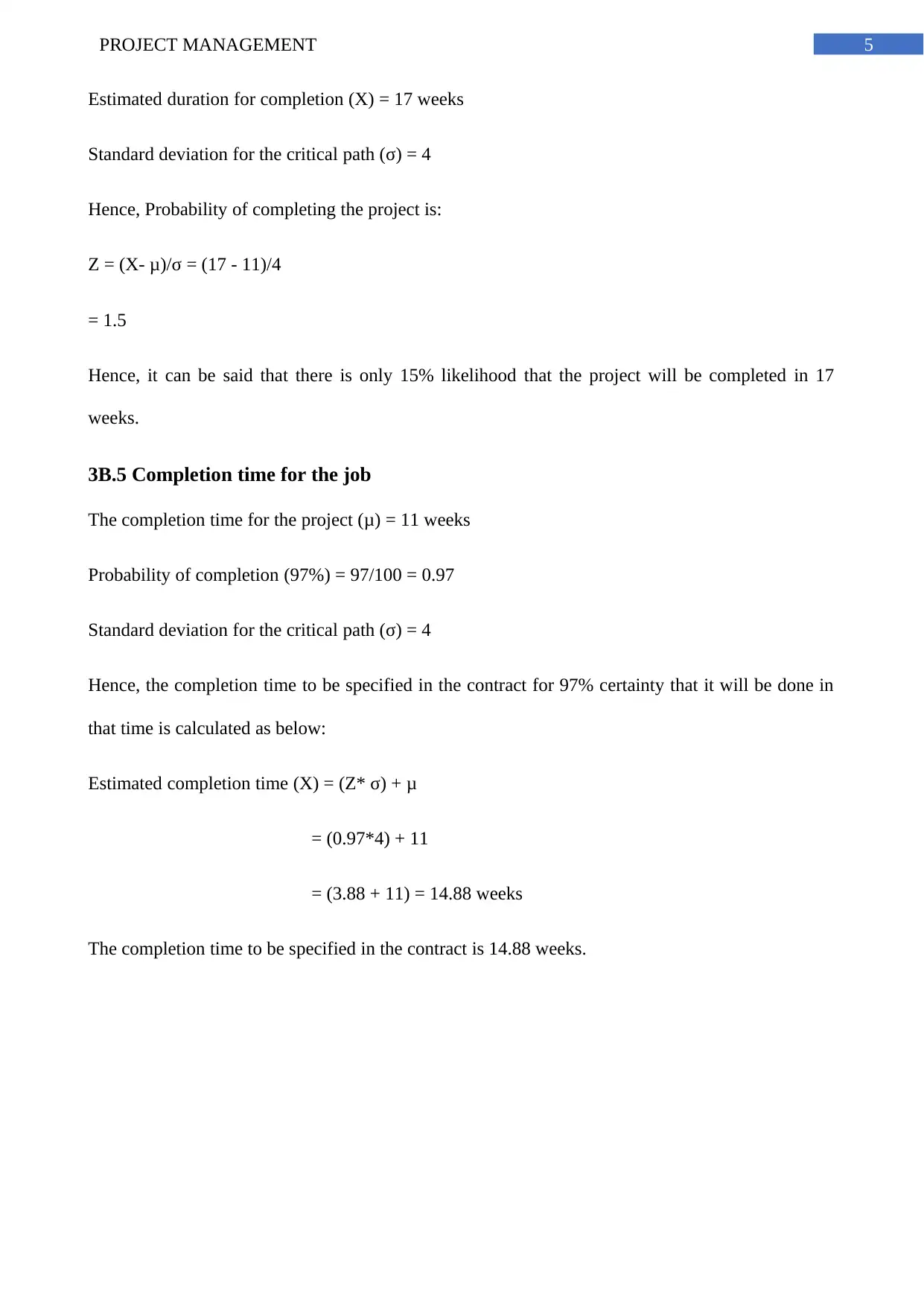
5PROJECT MANAGEMENT
Estimated duration for completion (X) = 17 weeks
Standard deviation for the critical path (σ) = 4
Hence, Probability of completing the project is:
Z = (X- μ)/σ = (17 - 11)/4
= 1.5
Hence, it can be said that there is only 15% likelihood that the project will be completed in 17
weeks.
3B.5 Completion time for the job
The completion time for the project (μ) = 11 weeks
Probability of completion (97%) = 97/100 = 0.97
Standard deviation for the critical path (σ) = 4
Hence, the completion time to be specified in the contract for 97% certainty that it will be done in
that time is calculated as below:
Estimated completion time (X) = (Z* σ) + μ
= (0.97*4) + 11
= (3.88 + 11) = 14.88 weeks
The completion time to be specified in the contract is 14.88 weeks.
Estimated duration for completion (X) = 17 weeks
Standard deviation for the critical path (σ) = 4
Hence, Probability of completing the project is:
Z = (X- μ)/σ = (17 - 11)/4
= 1.5
Hence, it can be said that there is only 15% likelihood that the project will be completed in 17
weeks.
3B.5 Completion time for the job
The completion time for the project (μ) = 11 weeks
Probability of completion (97%) = 97/100 = 0.97
Standard deviation for the critical path (σ) = 4
Hence, the completion time to be specified in the contract for 97% certainty that it will be done in
that time is calculated as below:
Estimated completion time (X) = (Z* σ) + μ
= (0.97*4) + 11
= (3.88 + 11) = 14.88 weeks
The completion time to be specified in the contract is 14.88 weeks.
⊘ This is a preview!⊘
Do you want full access?
Subscribe today to unlock all pages.

Trusted by 1+ million students worldwide
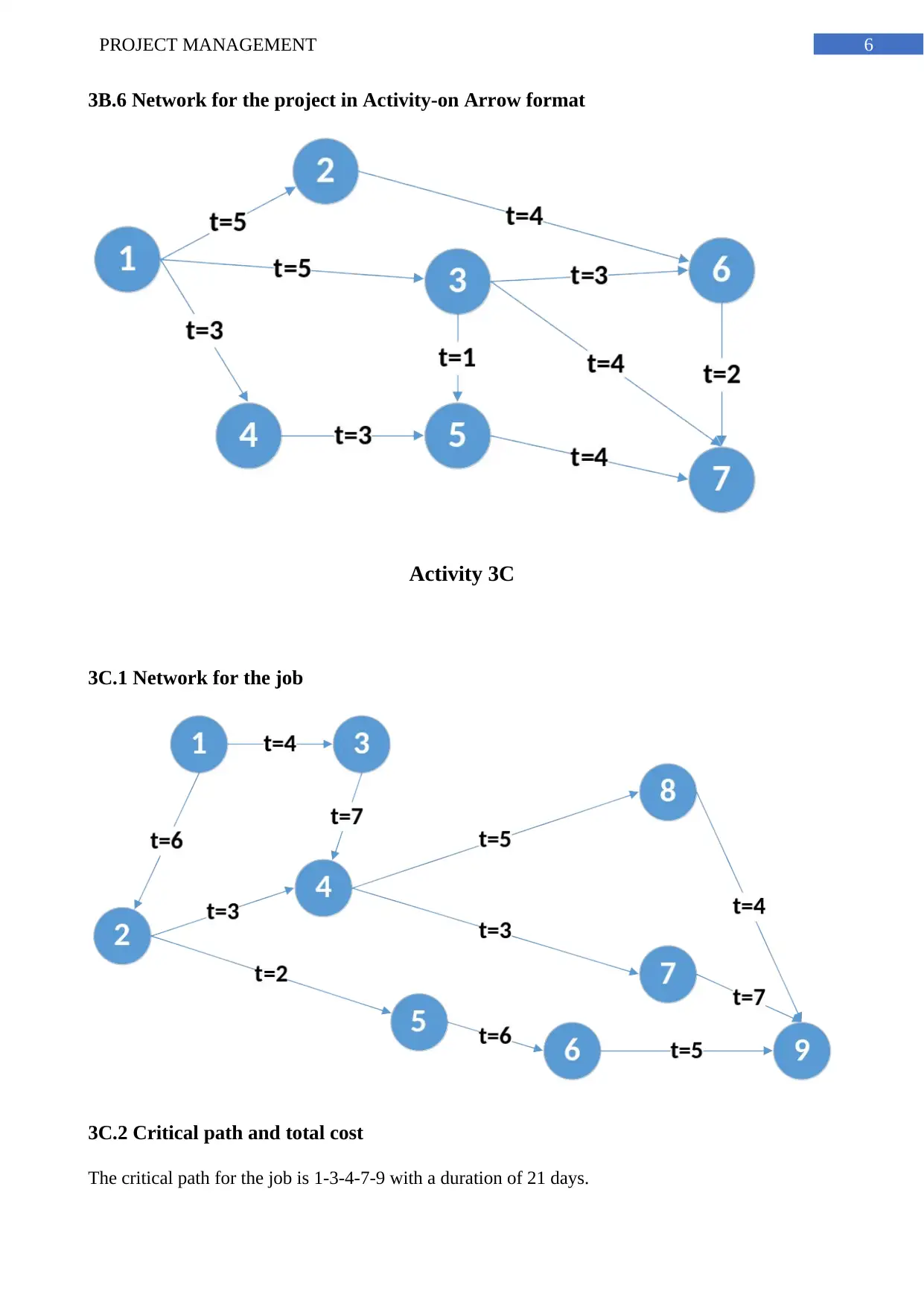
6PROJECT MANAGEMENT
3B.6 Network for the project in Activity-on Arrow format
Activity 3C
3C.1 Network for the job
3C.2 Critical path and total cost
The critical path for the job is 1-3-4-7-9 with a duration of 21 days.
3B.6 Network for the project in Activity-on Arrow format
Activity 3C
3C.1 Network for the job
3C.2 Critical path and total cost
The critical path for the job is 1-3-4-7-9 with a duration of 21 days.
Paraphrase This Document
Need a fresh take? Get an instant paraphrase of this document with our AI Paraphraser
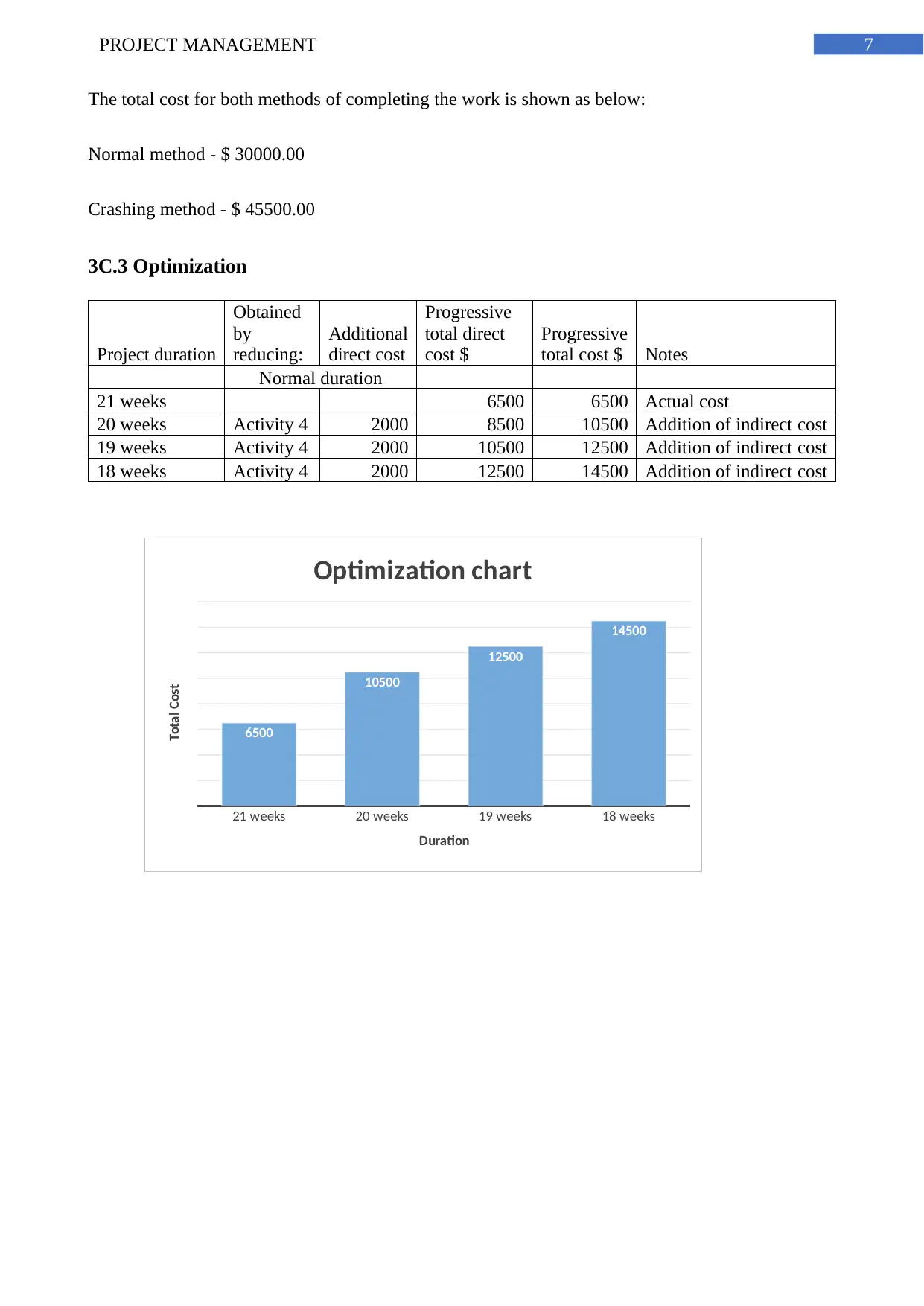
7PROJECT MANAGEMENT
The total cost for both methods of completing the work is shown as below:
Normal method - $ 30000.00
Crashing method - $ 45500.00
3C.3 Optimization
Project duration
Obtained
by
reducing:
Additional
direct cost
Progressive
total direct
cost $
Progressive
total cost $ Notes
Normal duration
21 weeks 6500 6500 Actual cost
20 weeks Activity 4 2000 8500 10500 Addition of indirect cost
19 weeks Activity 4 2000 10500 12500 Addition of indirect cost
18 weeks Activity 4 2000 12500 14500 Addition of indirect cost
21 weeks 20 weeks 19 weeks 18 weeks
6500
10500
12500
14500
Optimization chart
Duration
Total Cost
The total cost for both methods of completing the work is shown as below:
Normal method - $ 30000.00
Crashing method - $ 45500.00
3C.3 Optimization
Project duration
Obtained
by
reducing:
Additional
direct cost
Progressive
total direct
cost $
Progressive
total cost $ Notes
Normal duration
21 weeks 6500 6500 Actual cost
20 weeks Activity 4 2000 8500 10500 Addition of indirect cost
19 weeks Activity 4 2000 10500 12500 Addition of indirect cost
18 weeks Activity 4 2000 12500 14500 Addition of indirect cost
21 weeks 20 weeks 19 weeks 18 weeks
6500
10500
12500
14500
Optimization chart
Duration
Total Cost
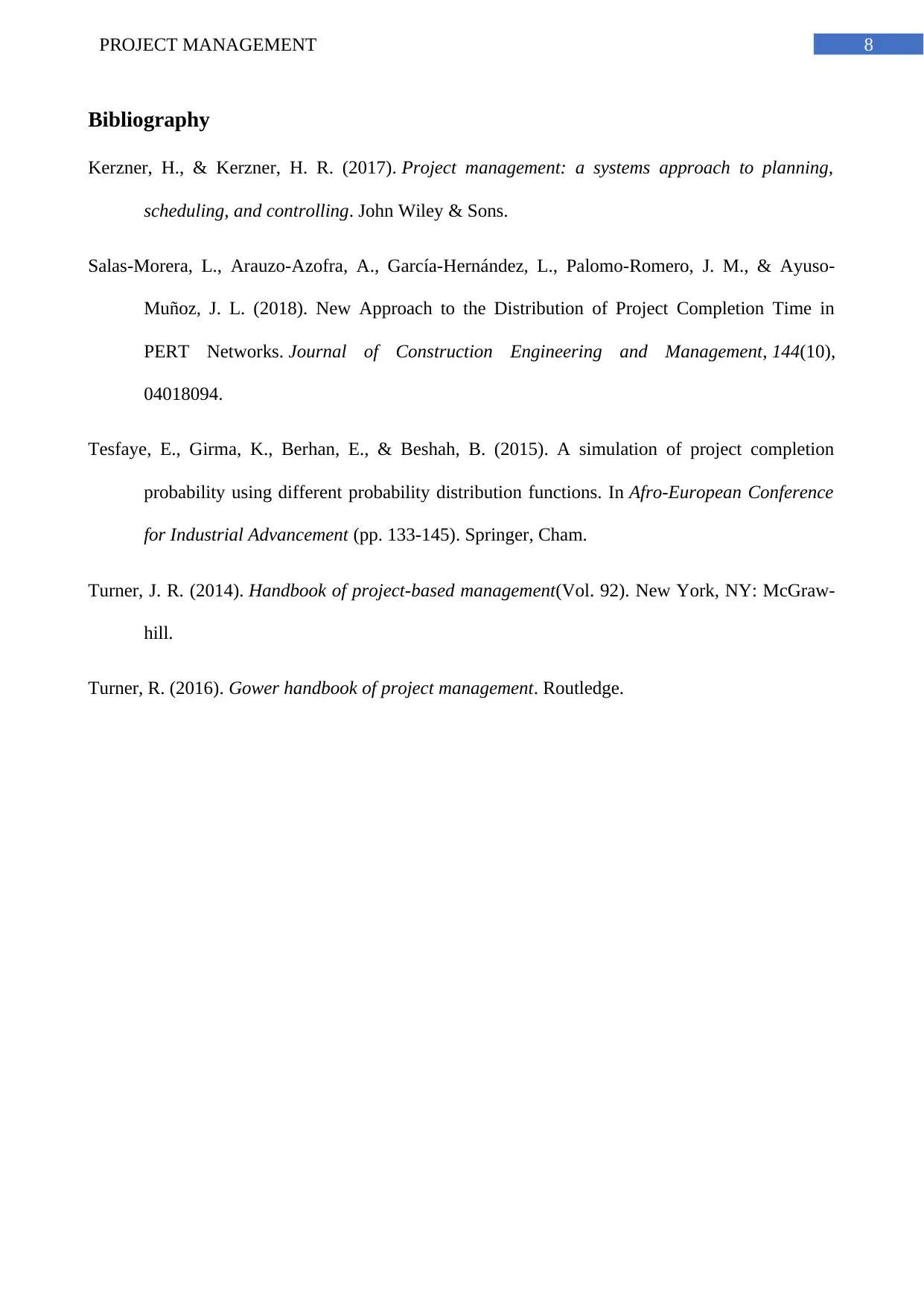
8PROJECT MANAGEMENT
Bibliography
Kerzner, H., & Kerzner, H. R. (2017). Project management: a systems approach to planning,
scheduling, and controlling. John Wiley & Sons.
Salas-Morera, L., Arauzo-Azofra, A., García-Hernández, L., Palomo-Romero, J. M., & Ayuso-
Muñoz, J. L. (2018). New Approach to the Distribution of Project Completion Time in
PERT Networks. Journal of Construction Engineering and Management, 144(10),
04018094.
Tesfaye, E., Girma, K., Berhan, E., & Beshah, B. (2015). A simulation of project completion
probability using different probability distribution functions. In Afro-European Conference
for Industrial Advancement (pp. 133-145). Springer, Cham.
Turner, J. R. (2014). Handbook of project-based management(Vol. 92). New York, NY: McGraw-
hill.
Turner, R. (2016). Gower handbook of project management. Routledge.
Bibliography
Kerzner, H., & Kerzner, H. R. (2017). Project management: a systems approach to planning,
scheduling, and controlling. John Wiley & Sons.
Salas-Morera, L., Arauzo-Azofra, A., García-Hernández, L., Palomo-Romero, J. M., & Ayuso-
Muñoz, J. L. (2018). New Approach to the Distribution of Project Completion Time in
PERT Networks. Journal of Construction Engineering and Management, 144(10),
04018094.
Tesfaye, E., Girma, K., Berhan, E., & Beshah, B. (2015). A simulation of project completion
probability using different probability distribution functions. In Afro-European Conference
for Industrial Advancement (pp. 133-145). Springer, Cham.
Turner, J. R. (2014). Handbook of project-based management(Vol. 92). New York, NY: McGraw-
hill.
Turner, R. (2016). Gower handbook of project management. Routledge.
⊘ This is a preview!⊘
Do you want full access?
Subscribe today to unlock all pages.

Trusted by 1+ million students worldwide
1 out of 9
Related Documents
Your All-in-One AI-Powered Toolkit for Academic Success.
+13062052269
info@desklib.com
Available 24*7 on WhatsApp / Email
![[object Object]](/_next/static/media/star-bottom.7253800d.svg)
Unlock your academic potential
Copyright © 2020–2025 A2Z Services. All Rights Reserved. Developed and managed by ZUCOL.





